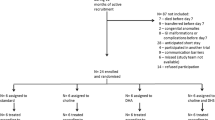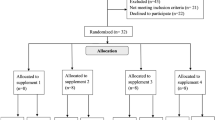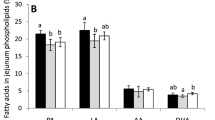Abstract
Docosahexaenoic acid (DHA, 22∶6n−3) is provided directly to human premature infants during parenteral nutrition from the egg yolk fraction of an intravenous fat emulsion. This study aimed to determine whether the high egg yolk phospholipid content of Intralipid 10% (IL 10%, Pharmacia, Uppsala, Sweden) relative to the standard emulsion Intralipid 20% (IL 20%, Pharmacia) could be a strategy to increase the delivery of DHA to the developing brain. Male, Large White piglets were randomly selected from sows 3 d after birth. Piglets were assigned to receive a 9-d continuous intravenous infusion commencing 5 d after birth of either Intralipid (IL) 10%, IL 20%, or Lipofundin S 20% (LFS; B. Braun, Melsungen, Germany). There were four piglets in each treatment group. IL 10% provides twice as much DHA as IL 20%, while LFS provides no DHA. Protein and other nutrients were provided enterally using a low-fat milk formula. After 9 d, animals were killed, and the fatty acid compositions of blood, liver, and cerebral cortex were analyzed. IL 10% infusion approximately doubled the amount of plasma phospholipid DHA (μg/mL of plasma) in comparison to IL 20%. However, red blood cells, liver, and cerebral cortex phospholipid DHA levels were indistinguishable between these two groups. LFS was associated with reduced levels of DHA in plasma, red blood cell and liver phospholipids in comparison to IL 20%. We conclude that infusion of additional phospholipid is an ineffective strategy for increasing DHA delivery to piglet tissues. This may be due to the formation of inert phospholipid particles in plasma. The data do not support the concept of using IL 10% as a means of providing additional DHA to premature human infants.
Similar content being viewed by others
Abbreviations
- DHA:
-
docosahexaenoic acid, 22∶6n−3
- IL 20%:
-
Intralipid 20%
- IL 10%:
-
Intralipid 10%
- LA:
-
linoleic acid
- LFS:
-
Lipofundin S
- LP-X:
-
lipoprotein X
References
Birch, E.E., Birch, D.G., Hoffman, D.R., and Uauy, R. (1992) Dietary Essential Fatty Acid Supply and Visual Acuity Development, Invest. Ophthalmol. Vis. Sci. 32, 3242–3253.
Carlson, S.E., Werkman, S.H., Rhodes, P.G., And Tolley, E.A. (1993) Visual Acuity Development in Healthy Preterm Infants: Effect of Marine-Oil Supplementation, Am. J. Clin. Nutr. 58, 35–42.
Simmer, K., Metcalf, R., and Daniels, L. (1997) The Use of Breastmilk in a Neonatal Unit and Its Relationship to Protein and Energy Intake and Growth, J. Paediatr. Child Health 33, 55–60.
American Academy of Pediatrics Committee on Nutrition (1985) Nutritional Needs of Low-Birth-Weight Infants, Pediatrics 75, 976–986.
Martinez, M. (1992) Tissue Levels of Polyunsaturated Fatty Acids During Early Human Development, J. Pediatr. 120, S129-S138.
Dobbing, J., and Sands, J. (1979) Comparative Aspects of the Brain Growth Spurt, Early Hum. Dev. 3, 79–83.
Morris, S.A., Simmer, K., and Gibson, R. (1999) Developmental Sensitivity of the Piglet Brain to Docosahexaenoic Acid, Pediatr. Res. 46, 401–405.
Morris, S., Simmer, K., van Barneveld, R., and Gibson, R.A. (1998) A Simplified Method to Study the Effect of Intravenous Fat Infusion in Neonatal Piglets, in Lipids in Infant Nutrition, (Huang, Y.-S., and Sinclair, A.J., eds.) AOCS Press, Champaign, pp. 100–110.
Broekhuyse, R.M. (1974) Improved Lipid Extraction of Erythrocytes, Clin. Chim. Acta 51, 341–343.
Bligh, E.G., and Dyer, W.J. (1959) A Rapid Method of Total Lipid Extraction and Purification, Can. J. Biochem. Physiol. 37, 911–917.
Morris, S., Simmer, K., and Gibson, R. (1998) Characterisation of Fatty Acid Clearance in Premature Neonates During Intralipid Infusion, Pediatr. Res. 43, 245–249.
Lutz, O., Meraihi, Z., Ferezou, J., Frey, A., Lutton, C., and Bach, A. (1990) The Mesophase of Parenteral Fat Emulsion Is Both Substrate and Inhibitor of Lipoprotein Lipase and Hepatic Lipase, Metabolism 39, 1225–1231.
Hajri, T., Ferezou, J., and Lutton, C. (1990) Effects of Intravenous Infusions of Commercial Fat Emulsions (Intralipid 10 or 20%) on Rat Plasma Lipoproteins: Phospholipids in Excess Are the Main Precursors of Lipoprotein-X-Like Particles, Biochim. Biophys. Acta 1047, 121–130.
Bach, A.C., Férezou, J., and Frey, A. (1996) Phospholipid-Rich Particles in Commercial Parenteral Fat Emulsions, an Overview, Prog. Lipid Res. 35, 133–153.
Innis, S.M. (1986) Effect of Total Parenteral Nutrition With Linoleic Acid-Rich Emulsions on Tissue ω6 and ω3 Fatty Acids in the Rat, Lipids 21, 132–138.
Arbuckle, L.D., Rioux, F.M., Mackinnon, M.J., Hrboticky, N., and Innis, S.M. (1991) Response of (n−3) and (n−6) Fatty Acids in Piglet Brain, Liver and Plasma to Increasing, but Low, Fish Oil Supplementation of Formula, J. Nutr. 121, 1536–1547.
Innis, S. (1989) Alteration of Erythrocyte Lipid Composition Following Total Parenteral Nutrition in the Rat, JPEN 13, 47–50.
Haumont, D., Deckelbaum, R.J., Richelle, M., Dahlan, W., Coussaert, E., Bihain, B.E., and Carpentier, Y.A. (1989) Plasma Lipid and Plasma Lipoprotein Concentrations in Low Birth Weight Infants Given Parenteral Nutrition with 10 or 20 Percent Lipid Emulsion, J. Pediatr. 115, 787–793.
Haumont, D., Richelle, M., Deckelbaum, R.J., Coussaert, E., and Carpentier, Y.A. (1992) Effect of Liposomal Content of Lipid Emulsions on Plasma Lipid Concentrations in Low Birth Weight Infants Receiving Parenteral Nutrition, J. Pediatr. 121, 759–763.
Author information
Authors and Affiliations
Corresponding author
About this article
Cite this article
Morris, S., Simmer, K. & Gibson, R. Utilization of docosahexaenoic acid from intravenous egg yolk phospholipid. Lipids 35, 383–388 (2000). https://doi.org/10.1007/s11745-000-535-9
Received:
Accepted:
Issue Date:
DOI: https://doi.org/10.1007/s11745-000-535-9




